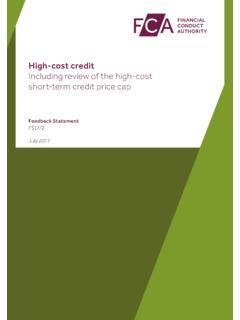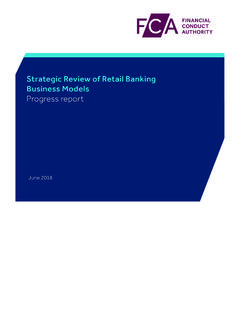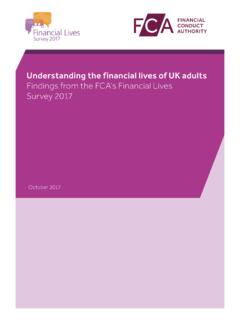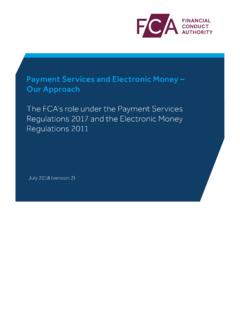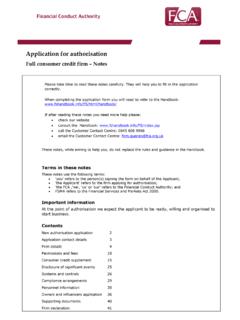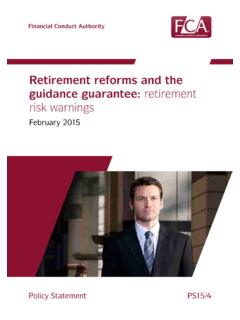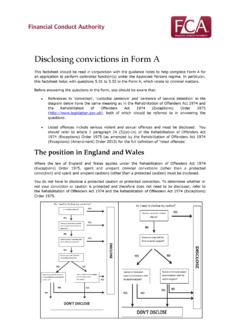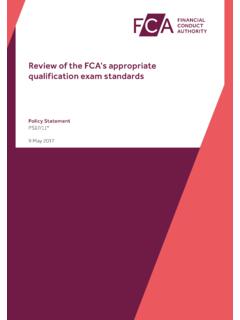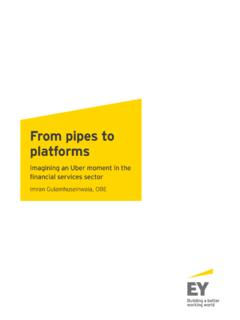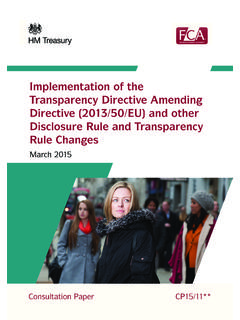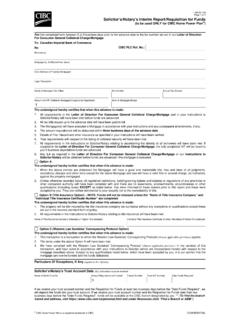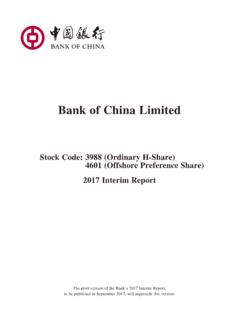Transcription of MS17/1.2: Investment Platforms Market Study Interim Report
1 Market StudyM S17/1 . 2 July 2018 Investment Platforms Market StudyInterim Report2M S17/1 . 2 Financial Conduct AuthorityInvestment Platforms Market StudyWe are asking for comments on this Report by 21 September 2018 You can send them to:Kate Blatchford-Hick Competition Division Financial Conduct Authority 12 Endeavour Square London E20 1 JNTelephone: 020 7066 8794 Email: investmentplatformsmarketstudy to respondContents1 Executive summary 32 Introduction 123 How do consumers choose, use and switch Platforms ? 164 Competition between adviser Platforms 365 Complexity and transparency of fees and charges 486 Do Platforms help consumers make good choices? 587 What consumer choices and firm strategies tell us about how competition is working 728 Barriers to entry and expansion 889 Areas for feedback and proposed remedies 95 Abbreviations used in this paper 108returns you to the contents listtakes you to helpful abbreviationsHow to navigate this document onscreen3 M S17/1.
2 2 Chapter 1 Financial Conduct AuthorityInvestment Platforms Market Study1 Executive Platforms are a relatively new but significant and growing distribution channel. The platform service provider Market has doubled since 2013 from 250bn to 500bn assets under administration (AUA). This growth in AUA has been driven by rising markets and increasing levels of Investment . More consumers are using Platforms , with an increase of around million more retail customer accounts between 2013 and 2 0 Platform revenue from retail consumers reached in 2017, up from 750m in 2013. There are 2 main types of Investment platform. Direct to Consumer (D2C) Platforms collectively administer 189bn and are used by consumers without the help of a financial adviser. Adviser Platforms collectively administer 311bn and are chosen by advisers but are paid for by consumers. Despite some new entry, the D2C Market remains concentrated, with a single platform having a Market share slightly higher than 40%.
3 In the adviser Market none of the top 4 Platforms achieves a 20% Market share and their Market shares have changed in recent years. Our Market Study looks at how competition is developing in this growing sector. Retail investors and financial advisers use Investment Platforms to access suppliers in one place, to execute, review and change their investments. Platforms can play an important role in the value chain by encouraging asset managers to compete for business. We wanted to assess the extent to which Platforms are competing to deliver these benefits in practice. In this Report we explain our findings and the way we want to see the Market develop. We welcome your comments. 1 FCA data. Just over a third of consumers appear to be using more than 1 platform and hence have multiple accounts. 4M S17/1 . 2 Chapter 1 Financial Conduct AuthorityInvestment Platforms Market StudyFigure : AUA on Platforms 2013 to 20170 100200 300 400 500 600 2013 2014 2015 2016 2017 Adviser AUA (billions)D2 COverallSource: FCA calculations based on firm : Figures from 2013 to 2016 refer to year-end stocks.
4 Figures for 2017 refer to the stock at end of did we find? We found a mixed picture. The Market appears to be working well in many respects, for both advised and non-advised consumers, and customer satisfaction is currently high. Consumers who pay more for their platform tend to get greater functionality on average. However, we are concerned that competition between Platforms is not working well for 5 groups of consumers. Switching between Platforms can be difficult. Consumers who would benefit from switching can find it difficult to do so. Shopping around can be difficult. Consumers who are price sensitive can find it difficult to shop around and choose a lower-cost platform. The risks and expected returns of model portfolios with similar risk labels are unclear. Consumers using these model portfolios may have the wrong idea about the risk-return levels they face.
5 Consumers may be missing out by holding too much cash. Consumers with large cash balances on D2C Platforms may not know they are missing out on Investment returns, the interest they lose or the charges they pay by holding cash in this way. So-called orphan clients who were previously advised but no longer have any relationship with a financial adviser face higher charges and lower addition, the positive impact of Platforms on competition between asset managers may be reduced because: Platforms employ commercial practices which may restrict fund managers incentives or ability to offer fund discounts to competitor Platforms , and this may reduce competition on fund discounts. 5 M S17/1 . 2 Chapter 1 Financial Conduct AuthorityInvestment Platforms Market Study Platforms could improve how they present fund charges at different stages of the consumer s decision are popular with investors, and competition is working well in some Users of D2C Platforms care about price and other features of Platforms , including the product range and ease of use.
6 On average, consumers who pay more get more functionality in return. We have not observed widespread instances of consumers paying more for no good reason. Platforms also compete to provide services that consumers use and value, including access to a wide range of investments and tools to help them manage their investments. Figure : Relationship between price and non-price features offered by Platforms functionalities (1=basic, 2=standard, 3=extensive)Revenue/ cat rating (average)D2C platformsAdviser Platforms Advised Platforms compete by offering services to advisers, but are paid for by consumers. Most of these services benefit consumers, although we have outlined some exceptions below. Platform financial performance does not suggest widespread competition concerns in the Market . We do not find sustained excess profitability on aggregate in this Market , and many Platforms are loss making.
7 Switching between Platforms can be difficult. Consumers who would benefit from switching can find it difficult to do so The switching process for investors is complex and time consuming. Almost half of consumers who have not switched nor considered switching platform are happy as they are. But we found that 7% of consumers have tried to switch at some point but failed mainly because of the time involved, the complexity of the process and exit fees. We are not concerned about the rate of switching per se, what matters is the ability to switch consumers should have the option even if they choose not to use it. The time it takes to switch between Platforms varies considerably. Switching is generally completed in a couple of weeks to a few months, but can take longer. We think barriers to switching are significant and could limit competitive pressure on Platforms .
8 Without this there is no pressure on providers to offer good .11 Advisers update their platform lists for new investments over time, but not many advisers switch existing investments as the process is complicated. This means that even if there are better options, which advisers use for new clients, they rarely switch existing investments across Platforms . Many advisers in our sample charge an extra fee for switching on top of their ongoing advice fee, which can cancel out the potential benefit of lower platform fees and act as an additional barrier. 6M S17/1 . 2 Chapter 1 Financial Conduct AuthorityInvestment Platforms Market We think that improving the switching process will encourage more competition and benefit all consumers. Shopping around can be difficult. Consumers who are price sensitive can find it difficult to shop around and choose a lower-cost platform 39% of non-advised consumers who have invested through Platforms told us they choose a platform based on the price they will be charged.
9 However, we have found that there are low levels of shopping around, with most non-advised consumers not shopping around or remembering doing so. Despite their stated importance, awareness of platform charges is fairly low with 29% of consumers either not knowing whether they pay charges for investing via a platform or thinking they do not pay any. Our consumer research suggests consumers are least satisfied with charges. We have also found that the most price sensitive consumers do not appear to be choosing the cheapest Platforms more often than other It is currently difficult for consumers to choose a D2C platform on the basis of price. It is not easy to find pricing information on platform websites. Most Platforms also have a large number of fees, different pricing structures and different ways of setting prices, for example, in pounds or as a percentage of the Investment amount.
10 Inconsistent language makes it even harder to identify and compare similar fees across Platforms . Different charging structures can in principle reflect different consumer needs and usage patterns. However, the level of complexity appears to go beyond catering for this, and we are concerned by both complexity and the lack of transparency. Platform fees vary so it is important that customers understand what they are paying. For example, charges on a pot of 5000 investing in stocks and shares ISA can vary from 20 bps to 240 bps, with a potential 650 difference in returns over a 5 year period (assuming a 5% growth rate). The MiFID II cost disclosure provisions should help consumers compare the total cost of However, there is scope for further improvement in how firms present the information mandated by MiFID II to consumers. The risks and expected returns of model portfolios with similar risk labels are unclear.
